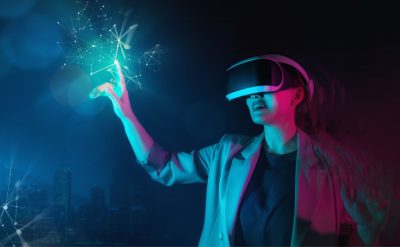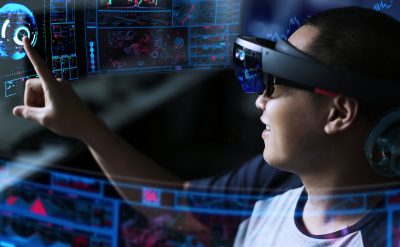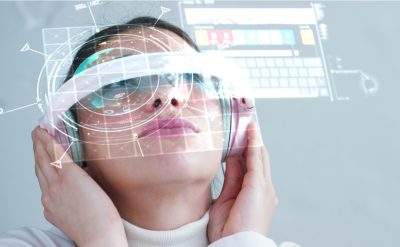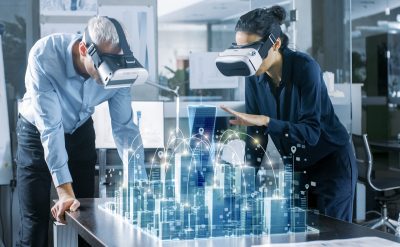What is augmented humanity?
When some particular technology like AI is infused with human qualities, it creates an appropriate bridge between the augmented and the human world called ‘Augmented Humanity.’
In simple terms, augmented humanity refers to a technology-enhanced way of living and working. Augmented humanity happens when humans work in harmony with technology and machine intelligence to enhance and enrich life, build better experiences, and make rational decisions.
The dictionary defines the word ‘augment’ as ‘increasing something and adding to it.’ In a similar pattern, augmented humanity includes both. Activities that improve human health and performance include teaching and learning, diet and exercise, training and practice, equipment, and tools. The way humans and technology interconnect with each other shows the potential to transform how humans live, work, and play.
Augmented humanity affects everything, from work and travel to shopping and engaging with a particular thing. It can reduce the time spent on repetitive manual tasks that can be automated, optimized or digitized, and makes that time more meaningful and productive.
Is it preparing human life for a better future?
In 2010, then Google CEO Eric Schmidt introduced the term ‘Augmented Humanity,’ describing it as a theory where devices are an extension of a human’s way of thinking.
Augmented devices act and make predictions based on user’s preferences. Whereas, today, the meaning of augmented humanity has slightly changed. Nowadays, it refers to the context of work and various ways of following next-generation technologies to expand a person’s physical and psychological potential.
In the growing sense, augmented humanity eliminates the barriers that prevent humans from doing good and productive work. Moreover, it seeks to arm employees and leaders with data-driven insights to make better decisions.
Here are some examples of augmented humanity devices – a smartwatch that reminds a wearer to get up and move after sitting for a longer time. Other wearable technologies such as Google Glass and virtual reality (VR) headsets are prime examples of augmented humanity devices. That’s because they heighten their users’ senses and perceptions.
Some implantable technologies, such as near-field communication (NFC) chips used in place of access cards, are also part of the augmented humanity spectrum. Software that automates research and data analysis are also considered augmented humanity devices.
Augmented humanity is a new form of working, an entirely new world where humans and machines coexist and enhance each other’s abilities. An era where machines will perform tasks traditionally done by humans to make the workplace more efficient and effective.
A prediction says future workforce and workplace should have the following four characteristics to form the core of socio-commercial enterprises –
- Augmentation over automation: Applications that improve the doer’s skills will replace people and processes. The conventional use of technology to automate work processes would become obsolete. More and more focus will be on making “human talent” irrelevant for anything and everything that can achieve through machines in the modern world of work.
- Demographics becoming irrelevant: Rapid learning and global exposure will get diminished soon due to the generation gap. Passions and talents, rather than demographics, would be the source of diversity. There will only be two groups of people in the modern world of work: those who are employable in the augmented workplace and those who are unemployed. Individuals’ age, gender, race, pedigree, and other factors will be insignificant in determining their position.
- Everchanging business models: There would be no such thing as a stable time for all companies. Product life cycles will be shorter and may even get reduced before reaching peak optimization. As a result, organizations would have to gain operating efficiencies with just “work in progress.”
- Upturned Maslow’s need hierarchy: The single most significant human need that will motivate fruitful endeavors will be self-actualization. In the modern world of work, taking care of the so-called essential needs would be so simple that their importance would possibly fade away.
Power of four Ms
Survival in the new world of individual and cultural competencies can be made possible only if each person and organization vow to transform themselves. The power of the following four Ms will help organizations prepare for a better future.
1. Meaning
Individuals will look only for those opportunities that make their work more meaningful in their context and purpose. Also, those who want to work for a lesser number of hours create greater impact and earn more money.
Organizations, therefore, will have to rework on creating a completely new set of roles and jobs in place of the current ones. Ironically, people will choose those jobs more that require even the mundane essentials to be excluded. It will be done with the help of advanced mechanisms such as machine learning (ML), natural language processing (NLP), and artificial intelligence (AI).
2. Mastery
In the augmented age, mastery over a particular area that is unique will be the critical point.
Employees will feel confident about their organizations only when they know that organizations are ensuring what they want. Hence, organizations need to understand what mastery means for each employee when it comes to working. Also, they need to take care of what should be introduced as tools and types of culture to nurture mastery in individuals.
Like the concept of employee engagement, it will develop mastery over one person and one topic at a time. Organizations will have to change their approach completely, not just from the enablement point of view but also from a cultural standpoint.
3. Mobility
Shortly, mobility will be much more than relocations. Moreover, work itself will be ‘Mobile.’ Many will choose to work ‘on parts’ or ‘in parts.’ This means complex tasks will be divided into little tasks that humans will look upon while bots will perform the algorithm. To be precise, anyone will do work from anywhere and at any time.
The other advantage of mobility will be people need not be sector specialists anymore. They can be artisans who use their specific mastery in different industries, irrespective of the geographies and tasks. In the end, human interest will be short-lived as they will be switching over their careers and not just the jobs.
Therefore, organizations will need to prepare themselves to support and leverage the above-stated conditions.
4. Mindfulness
Humans will have to create an entirely new neurological network that would help them aid a meaningful human contribution in an extremely distracting, augmented digital arena. Mindfulness and connecting with the greater consciousness ought to be the only peer point to outsmart machines. Practicing mindfulness will be not only an option but also a part of the survival imperative.
Therefore, organizations will have to redesign their talent development policies for a better employee environment. It will be more important to work on workplace ergonomics that is evolving from physical to spiritual wellbeing.
These four Ms play a key role in solving the seen and unseen challenges that future businesses hold.
Toward a better future
Today’s innovation has proven its ability and indicates that a productive life is a happy life. No doubt, augmented humanity technologies may lack emotional capabilities and excel in maintaining balance at a workplace. But, for sure, they add value to human endeavors. There will be times when there will be no barriers between AI and human capabilities. Yes, this idea is hard to believe, but looking at modern devices’ potential, one can strongly believe it.
For the near future, staying competitive makes companies align new technologies with new value propositions and turn human factors into the center of their strategies. Organizations will have to leverage human-machine interactions to broaden the human cognitive, physical capabilities that challenge accessibility boundaries and develop solutions to align individuals and societies’ needs at large.
To learn more about augmented reality and other related technologies, visit our whitepapers.


































































